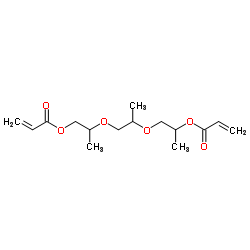Tri(propylene glycol) diacrylate

Tri(propylene glycol) diacrylate structure
|
Common Name | Tri(propylene glycol) diacrylate | ||
|---|---|---|---|---|
| CAS Number | 42978-66-5 | Molecular Weight | 300.348 | |
| Density | 1.0±0.1 g/cm3 | Boiling Point | 368.9±22.0 °C at 760 mmHg | |
| Molecular Formula | C15H24O6 | Melting Point | N/A | |
| MSDS | Chinese USA | Flash Point | 158.1±22.4 °C | |
| Symbol |


GHS07, GHS09 |
Signal Word | Warning | |
|
Electrochemical sensor for parabens based on molecular imprinting polymers with dual-templates.
Anal. Chim. Acta 673(2) , 145-50, (2010) A selective, sensitive, rapid and reliable method based on molecularly imprinted polymers (MIPs) with dual templates to determine total content of parabens in cosmetics was developed. With methylparaben (MP) and propylparaben (PP) as dual-templates, methacryl... |
|
|
A novel polyurethane-based root canal-obturation material and urethane-acrylate-based root canal sealer-part 2: evaluation of push-out bond strengths.
J. Endod. 34(5) , 594-8, (2008) We have developed a visible-light curable urethane-acrylate/tripropylene glycol diacrylate (UA/TPGDA) oligomer to serve as a root canal sealer and a zinc oxide/thermoplastic polyurethane (ZnO/TPU) composite to serve as a root canal obturation material. The pu... |
|
|
Occupational dermatitis to ultraviolet-cured acrylic-based inks in computer hard disc manufacturing.
Am. J. Contact Dermatitis 9(3) , 179-81, (1998) Ultraviolet-cured acrylates and their various components and applications are reviewed in this report.A 26-year-old woman involved in silk screening computer discs with ultraviolet-cured inks developed an acute allergic contact dermatitis on her hands and for... |
|
|
Binding efficiency and transport properties of molecularly imprinted polymer thin films.
J. Am. Chem. Soc. 124(28) , 8290-6, (2002) A model system for the characterization of molecular recognition events in molecularly imprinted polymers (MIPs) is presented. The use of a biologically inspired, three-point hydrogen-bonding motif and a thin film polymeric matrix allows for pre- and post-pol... |
|
|
A tape-stripping method for measuring dermal exposure to multifunctional acrylates.
Ann. Occup. Hyg. 44(8) , 645-51, (2000) Current methods for measuring dermal exposure to skin irritants and allergens, such as acrylates, have significant drawbacks for exposure assessment. A noninvasive sampling method has been developed and tested for measuring dermal exposure to a multifunctiona... |
|
|
Comparative in vitro cytotoxicity of ethyl acrylate and tripropylene glycol diacrylate to normal human skin and lung cells.
In Vitro Cell. Dev. Biol. Anim. 36(9) , 611-6, (2000) The potential for occupational exposure to the esters of acrylic acid (acrylates) is considerable, and, thus, requires a greater understanding of the their toxicity. Confluent (70-90%) cultures of normal human epidermal keratinocytes (NHEK), dermal fibroblast... |
|
|
Absence of systemic in vivo genotoxicity after dermal exposure to ethyl acrylate and tripropylene glycol diacrylate in Tg.AC (v-Ha-ras) mice.
Environ. Mol. Mutagen. 29(3) , 240-9, (1997) Acrylates may be polymerized to stable surface coatings (paints, lacquers, inks, etc.) by alkylation via the Michaelis-type addition reaction. Thus, acrylates have an inherent potential as electrophiles to be genotoxic, limited in their biological activity by... |
|
|
Workers' dermal exposure to UV-curable acrylates in the furniture and Parquet industry.
Ann. Occup. Hyg. 44(8) , 635-44, (2000) The use of ultraviolet radiation-curable coatings (UV-coatings) has increased rapidly in the parquet and furniture industry. Work with UV-coatings involves risk from skin exposure to chemically reactive, concentrated acrylates that are known skin contact irri... |
|
|
Tripropylene glycol diacrylate but not ethyl acrylate induces skin tumors in a twenty-week short-term tumorigenesis study in Tg.AC (v-Ha-ras) mice.
Toxicol. Pathol. 26(4) , 476-83, (1998) The toxicity of the esters of acrylic acid are poorly understood even though significant human exposure occurs. To conduct rapid comparative short-term bioassays, we used the Tg.AC (v-Ha-ras) transgenic mouse model to determine the toxicity and potential carc... |